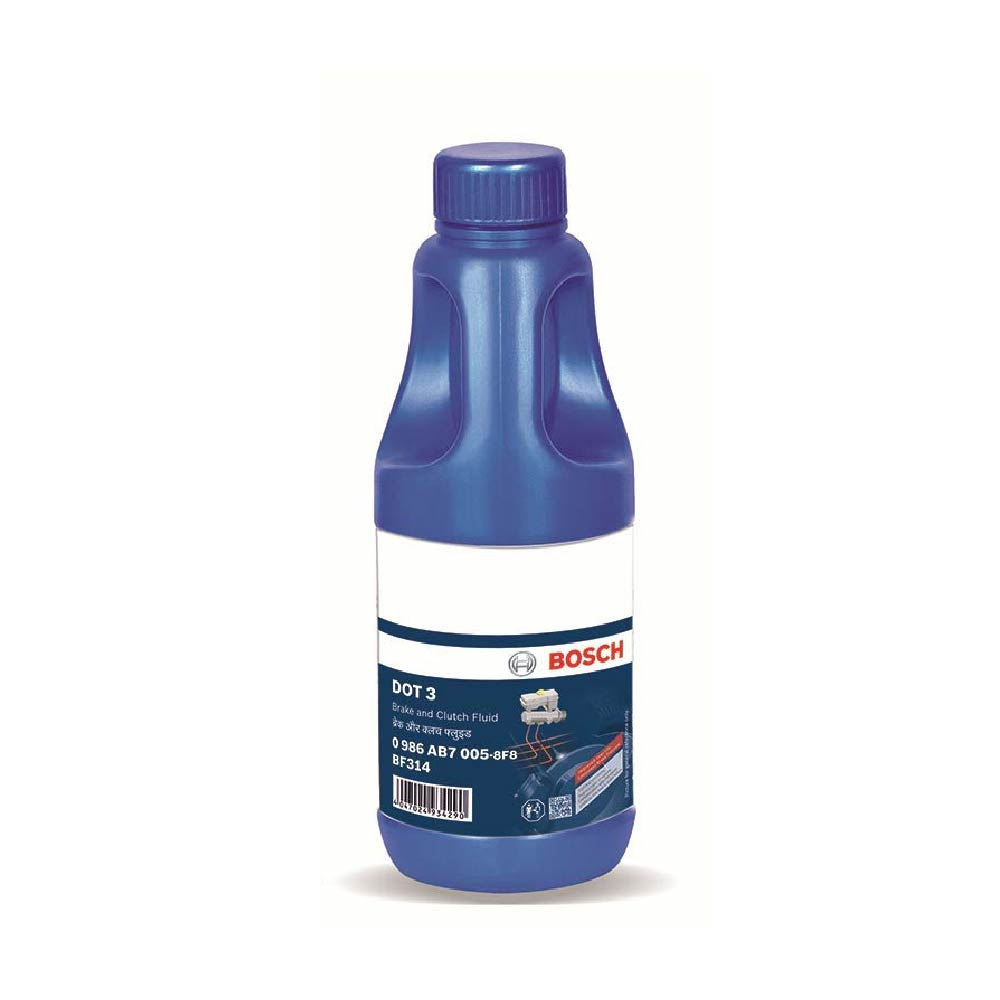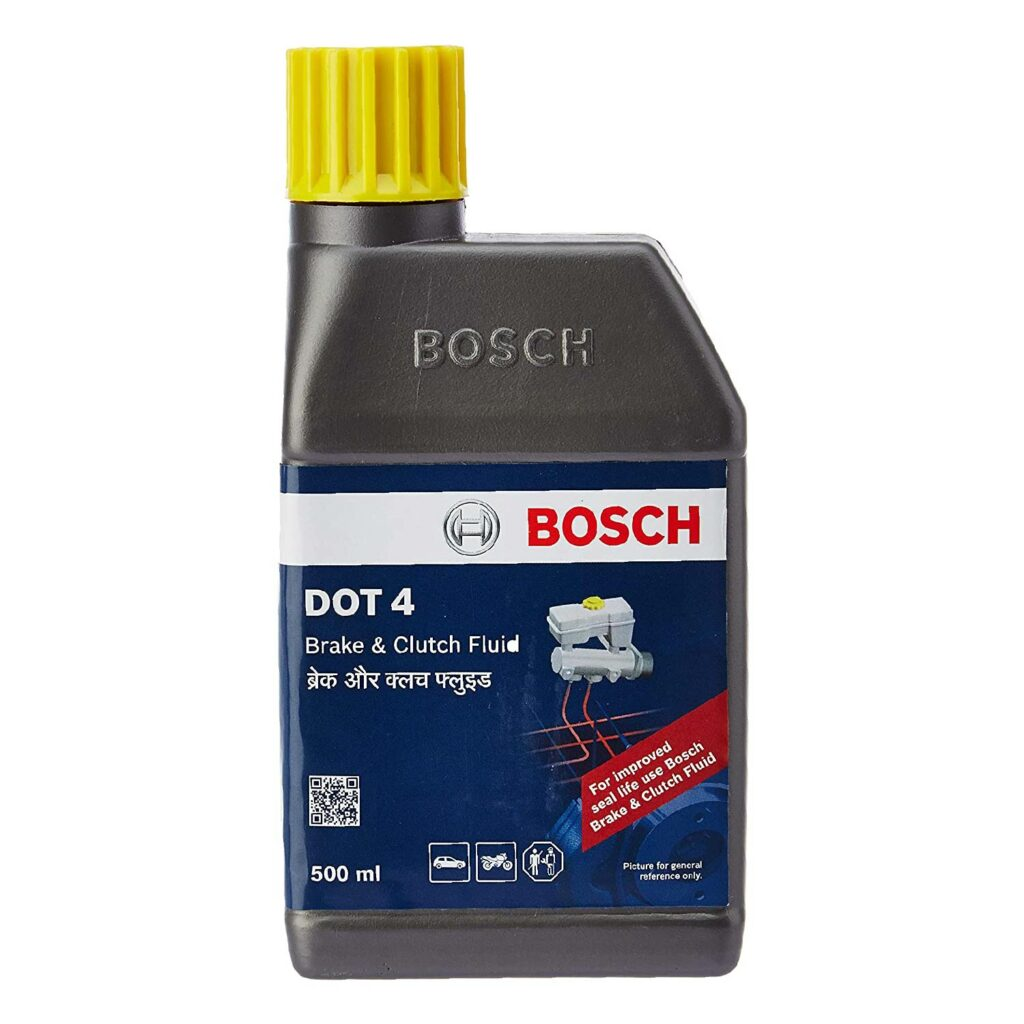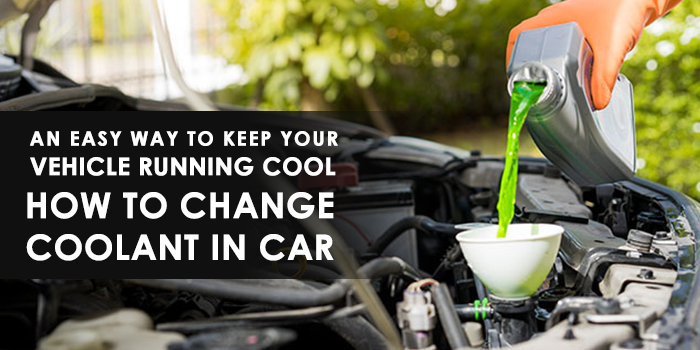
Brakes are really important for driving safely, we all know that. Since all these years, braking systems have seen advancements and some safety features have now become standard across all vehicles. From pumping brakes to ABS, we have travelled a long way. But braking systems also need some care and neglecting them for long could get you in a mishappening. To improve your understanding, we tell you what are brake fluids and what’s the difference between DOT3, DOT4 and DOT5 brake fluid.
What is Brake Fluid?
Brake fluid is one of the essential vehicle fluids necessary for your car to function properly. Before diving into the concepts of brake fluids, one should obviously have a basic understanding of what brake fluid actually is. An automotive braking system converts the kinetic energy into heat in a bit to reduce the momentum of the vehicle. In modern-day cars, brake fluid is used to create the pressure that puts the brake pads and rotors into work. Brake fluid is a type of hydraulic fluid that transfers the force from the brake pedal to the brake calliper. The brake callipers then rub against the rotor to reduce the momentum. The braking force is directly proportional to the force the driver has put on the brake pedal or lever.
For having the perfect braking performance and feedback, having the correct braking fluid is very important. Having incorrect brake fluid could result in a longer braking distance and even brake failure. In the worst-case scenario, the pedal could have free play and despite pressing the pedal to the end, the vehicle won’t stop. Brake fluids are represented and categorised by their DOT ratings. DOT stands for Department of Transportation, an agency that defines the ratings. DOT ratings can be simplified with three properties – chemical substance, boiling point and moisture containment over time.
How Does Brake Fluid Work?
Brake fluid operates on the principle of hydraulic pressure to transfer force from the brake pedal to the braking components, which causes the tyre to stop rotating and brings the vehicle to a stop. Heres how brake fluid works:
Hydraulic System
Brake fluid is part of the hydraulic system that tramits force from one point to another. Pressing the brake pedal creates pressure in the fluid which is used to apply force on the brake calipers which push brake pads against the brake rotor. The system is completely air tight to prevent moisture from entering the brake fluid and to maintain adequate pressure when force is applied through the system.
Master Cylinder:
The brake pedal is connected to the master cylinder which is filled with brake fluid. It pushes a cylinder in the master cylinder when the brake pedal is applied and transfer force through the hydraulic brake system. The master cylinder is located in the engine bay near the firewall.
Hydraulic Pressure:
As you push the brake pedal, it squeezes the brake fluid under high pressure and transfers that force from the master cylinder throughout the brake lines.
Brake Calipers and Slave Cylinders:
At the other end of the brake line is a slave cylinder which receives the force created by the master cylinder. It applies pressure on the brake calipers (in the case of disc brakes) or brake pads (in the case of drum brakes) at each wheel.
Brake Pads or Brake Shoes:
The brake pads are pushed against the brake rotor by the force applied at the brake pedal by the driver. The components make contant and create a large amount of friction, which slows the rotating wheel and eventually causes the vehicle to stop. This process produces a large amount of heat along with friction.
Brake Pedal Release:
When the brake pedal is released, the pressure in the brake fluid is reduced. This allows springs in the brake caliper or brake shoes to move away from the rotor or drum. The vehicle wheel is free to move now and can accelerate without any resistance.
Brake Fluid Properties:
Brake fluid has a high boiling point to withstand high temperatures and pressure whil braking. It also contain additives that prevent it from freezing in the winter.
As brake fluid can absorb mosiute over time, it can deteriorate, reduce braking performance and damage the braking system. Refer to your vehicle service manual to identify when brake fluid should be replaced and topped up.
DOT3, DOT4 and DOT5 Brake Fluids Explained
There are three brake fluids available in the market for our general vehicles. The range increases in terms of performance in the ascending order, which means the DOT3 is the most basic one and the DOT5 is the sophisticated one with richer substances. However, DOT4 is now the general choice in our regular vehicles.
DOT3 Brake Fluid Explained
DOT3 Brake Fluid is the most generic one available in the market. DOT3 brake fluid typically includes around 80% of Glycol and other substances account for the rest. DOT3 brake fluid is generally yellow in colour. There is no sure shot standards for DOT3 or any other brake fluid for that matter, and the boiling points vary from brand to brand. In a nutshell, DOT3 fluid generally has a dry boiling point of 205 degrees celsius and a wet boiling point of 140 degrees celsius. The wet boiling point is taken into consideration when the fluid has gained moisture with time. However, DOT3 gains less moisture with respect to time, over DOT4 fluid.

DOT4 Brake Fluid
DOT4 brake fluid is the one that is now used in most of our vehicles. It bridges the gap between DOT3 and DOT4 by offering qualities of both the other two fluids at an attainable cost. Talking of substances used, DOT4 brake fluid includes around 50-65% of Glycol ether base with around 20-40% of Borate Ester base. DOT4 brake fluid has higher boiling points than DOT3, 230 degrees Celsius for dry and 155 degrees Celsius for wet. Talking of properties, DOT4 gains moisture quicker than DOT3 but has a high boiling point for both dry and wet conditions. Hence, it offers more reliable braking power but demands a quicker fluid change.

DOT5 Brake Fluid
DOT5 Brake Fluid is used in high-grade vehicles that are mostly built to tackle high-intensity conditions. DOT5 is a fully synthetic silicone-based brake fluid that doesn’t contain any moisture, with time. It offers more compressibility than both DOT3 and DOT4 brake fluids. DOT5 brake fluid also has a higher boiling point of 260 degrees Celcius in dry and 180 degrees Celcius in wet. Due to no moisture content, it is the most reliable brake fluid and offers stupendous braking performance with a longer replacement lifecycle. However, some brands are now offering fully synthetic DOT4 brake fluids as well that offer even higher boiling points than DOT5, hence those are more preferable for on-road use.

Difference Between DOT3, DOT4 and DOT5 Brake Fluid
Brake fluid OEMs have shown various advancements and the competition bar has got higher. Hence there is no short formula or pre-determined standards for brake fluids. But here are the general differences that are seen among all the three brake fluids available.
DOT3 brake fluid is the generic option and it contains less moisture with time. That means you need to replace the brake fluid less frequently. On the other hand, DOT4 brake fluids contain moisture quicker than DOT3, thus demanding an earlier replacement. However, the high boiling point of the DOT4 brake fluid is preferred as the moisture content doesn’t affect braking as much in low temperatures.
It is worth noting that you should always stick to the brake fluid grade recommend by the OEM. If your owner manual suggests using DOT3, do not replace it with DOT4 or vice versa. Changing the grade can damage or corrode your braking system due to the content of moisture and it could hamper the braking performance. In addition to that, never mix DOT3 with DOT4 brake fluid as the chemical reactions between the brake fluids could result in brake failure.
How Does Moisture Affect Braking Performance?
Brake fluids are often also termed incompressible fluids. It’s the main property that is responsible to transfer force from the pedal to the brake callipers. If the fluid is compressible, the force won’t reach the brake callipers in the same quantity that is required, hence affecting the braking performance. We all know that moisture is compressible and it can form into gas, under pressure and problems start from here.
If moisture is mixed with brake fluid, it will affect its incompressible property and under pressure, the moisture will become gas and compress and eventually, reduce the braking force. Having moisture in abundance can even make the braking system redundant with a lot of free play on the braking pedal. Hence, it is always recommended to change the brake fluid regularly and always tight up the cap of the fluid storage.
FAQ:
Q1. Can I use DOT4 instead of DOT3?
Ans. No, it is always recommended to use the grade that has been suggested by the OEM. Changing the grade can decrease the braking performance and also corrode the braking system.
Q2. How often to change DOT4 brake fluid?
Ans. DOT4 brake fluid demands earlier replacement when compared to DOT3 brake fluid. However, every brand suggests a different replacement timeline, hence it is advised to check the user manual of your vehicle.
Q3. Can you put DOT4 in DOT3 brake fluid?
Ans – No, mixing DOT4 in DOT3 brake fluid could be harmful to your braking system. The properties and substances of both the fluids are different and the chemical reaction between the two could affect the braking system and even result in system failure.
Q4. Where to buy DOT5 brake fluid?
Ans. You can buy DOT5 brake fluid from your nearest authorised service provider or buy from Carorbis online marketplace.
Q5. Can I use DOT5 instead of DOT4?
Ans. No, it is always recommended to use the grade that has been suggested by the OEM. Changing the grade can decrease the braking performance and also corrode the braking system.
If you found this blog helpful, make sure to check out more informative articles on the Carorbis Blog and also read Car Suspension – Working and Different Types Explained








